Science Daily News | 09 Jul 2023

Views (128)

An Iowa meteorologist started talking about climate change on newscasts. Then came the harassment
The harassment started to intensify as TV meteorologist Chris Gloninger did more reporting on climate change during local newscasts — outraged emails and even a threat to show up at his house. Gloninger said he had been recruited, in part, to “shake things up” at the Iowa station where he worked, but backlash was building. The man who sent him a series of threatening emails was charged with third-degree harassment.
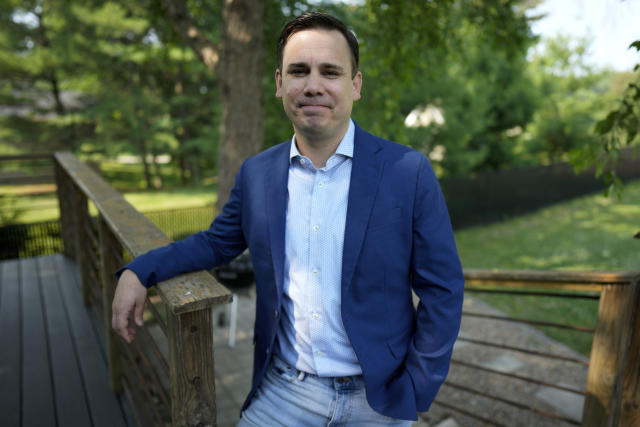
DES MOINES, Iowa (AP) — The harassment started to intensify as TV meteorologist Chris Gloninger did more reporting on climate change during local newscasts — outraged emails and even a threat to show up at his house.
Gloninger said he had been recruited, in part, to “shake things up” at the Iowa station where he worked, but backlash was building. The man who sent him a series of threatening emails was charged with third-degree harassment. The Des Moines station asked him to dial back his coverage, facing what he called an understandable pressure to maintain ratings.
“I started just connecting the dots between extreme weather and climate change, and then the volume of pushback started to increase quite dramatically,” he said in an interview with The Associated Press.
So, on June 21, he announced that he was leaving KCCI-TV — and his 18-year career in broadcast journalism altogether.
Gloninger's experience is all too common among meteorologists across the country who are encountering reactions from viewers as they tie climate change to extreme temperatures, blizzards, tornadoes and floods in their local weather reports. For on-air meteorologists, the anti-science trend that has emerged in recent years compounds a deepening skepticism of the news media.
For several years now, Gloninger said, “beliefs are amplified more than truth and evidence-based science. And that is not a good situation to be in as a nation.”
Gloninger’s announcement sent reverberations through a national conference of broadcast meteorologists in Phoenix, where many shared their own horror stories, recalled Brad Colman, president of the American Meteorological Society.
“They say, ‘You should have seen this note.’ And they try to take it with a smile, a lighthearted laugh,” Colman said. “But some of them are really scary.”
Meteorologists have long been subjected to abuse, but that has intensified in recent years, said Sean Sublette, a former TV meteorologist and now the chief meteorologist for the Richmond Times-Dispatch.
“More than once, I’ve had people call me names or tell me I’m stupid or these kinds of harassing type things simply for sharing information that they didn’t want to hear," he said.
A decade ago, far fewer TV meteorologists were talking about climate change on air, although they wanted to do so, said Edward Maibach, the director of the Center for Climate Change Communication at George Mason University.
The Weather Channel gave its first climate reporter, scientist Heidi Cullen, a dedicated show in 2006. She faced bitter and sexist resistance from some viewers, including conservative leaders, as she challenged other TV forecasters to address global warming in their reporting.
Climate Matters, a National Science Foundation-funded project, piloted in 2010 and fully launched in 2012 to support reporting on climate change by providing data analysis, graphics and other reporting materials.
Now TV meteorologists across the country report on climate change, though Maibach said they don’t always use those words. It is increasingly common to at least show its effects, he said, like highlighting the trend of more days in a year hitting temperatures above 90 degrees (32 degrees Celsius).
Even if that kind of reporting resonates with most people, the criticism can be the loudest.
“If you stop reporting on relevant and important facts about what’s going on in your community because you’re hearing from the one out of 10, it means you are not serving the other nine out of 10,” Maibach said.
Some meteorologists have seen public interest in climate change grow even in largely red states as flooding, drought and other severe weather has ravaged farmland and homes. Jessica Hafner, chief meteorologist at Columbia, Missouri’s KMIZ-TV, said that with the exception of a few hecklers, she's seen people respond well to data-based reporting because they want to know what's going on around them.
Meteorologist Matt Serwe, who used to work in Nebraska, said the livelihoods of farmers who live there depend on the weather, so they take climate change seriously.
“You want to know how you can best succeed with these conditions," he said. "Because at that point, it’s survival.”
It’s not just a problem in the United States. Meteorologists in Spain, France, Australia and the U.K. also have been subjected to complaints and harassment, said Jennie King, the London-based head of climate research and policy at the Institute for Strategic Dialogue.
Some meteorologists don’t see harassment as a direct result of their reporting on climate change; it's a pervasive issue in the industry and targets some more than others. TV reporters are more likely than reporters in other mediums to say they have been harassed or threatened, according to Pew Research Center polling in 2022.
“Science is under attack in this country,” said Chitra Kumar, managing director of Climate and Energy at the Union of Concerned Scientists. “It’s this larger trend. It’s really unacceptable from our perspective that anyone should have to fear for their lives for merely stating the facts.”
Gloninger, 38, is moving back to Boston to care for aging parents, but he says he’s leaving Des Moines having realized that a small percentage of people who reject climate change make up an overwhelming percentage of the negative comments he has gotten.
“I know that now with the feedback that I’ve received after the fact, with hundreds of emails, dozens of handwritten letters,” he said of messages that have come from all over the state. KCCI-TV didn’t respond to request for comment.
“This incident is not representative of what Iowans are and what they believe,” Gloninger added. “At the end of the day, the people have been incredibly supportive — not just of me, but of the efforts that my station has made in covering climate.”
___
Hollingsworth reported from Mission, Kansas, and Ballentine from Columbia, Missouri.
Insects find their way onto Italian plates despite resistance
Pulverising crickets to make flour for food is seen by some as a threat to the Mediterranean diet.
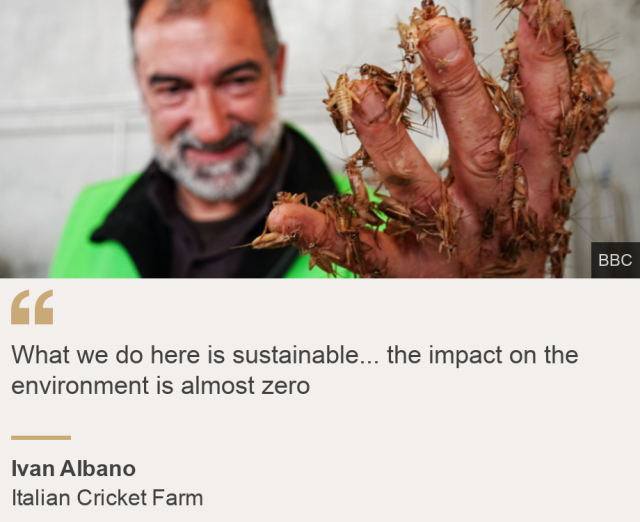
In a small room near the Alps in northern Italy, containers filled with millions of crickets are stacked on top of each other.
Jumping and chirping loudly - these crickets are about to become food.
The process is simple: they are frozen, boiled, dried, and then pulverised.
Here at the Italian Cricket Farm, the biggest insect farm in the country, about one million crickets are turned into food ingredients every day.
Ivan Albano, who runs the farm, opens a container to reveal a light brown flour that can be used in the production of pasta, bread, pancakes, energy bars - and even sports drinks.
Eating crickets, ants and worms has been common in parts of the world like Asia for thousands of years.
Now, after the EU approved the sale of insects for human consumption earlier this year, will there be a shift in attitudes across Europe?
"We will oppose, by any means and in any place, this madness that would impoverish our agriculture and our culture," Deputy Prime Minister Matteo Salvini wrote on Facebook.
But is that all about to change? Several Italian producers have been perfecting cricket pasta, pizza and snacks.
"What we do here is very sustainable," says Ivan. "To produce one kilo of cricket powder, we only use about 12 litres of water," he adds, pointing out that producing the same quantity of protein from cows requires thousands of litres of water.
Farming insects also requires just a fraction of the land used to produce meat. Given the pollution caused by the meat and dairy industry, more and more scientists believe insects could be key to tackling climate change.
At a restaurant near Turin, chef Simone Loddo has adapted his fresh pasta recipe, which dates back nearly 1,000 years - the dough is now 15% cricket powder.
It emanates a strong, nutty smell.
Some of the diners refuse to try the cricket tagliatelle, but those who do - including me - are surprised at how good it tastes.
Aside from the taste, cricket powder is a superfood packed with vitamins, fibre, minerals and amino acids. One plate contains higher sources of iron and magnesium, for example, than a regular sirloin steak.
But is this a realistic option for those who want to eat less meat? The main issue is the price.
"If you want to buy cricket-based food, it's going to cost you," says Ivan. "Cricket flour is a luxury product. It costs about €60 (£52) per kilogram. If you take cricket pasta for example, one pack can cost up to €8."
That's up to eight times more than regular pasta at the supermarket.
For now, insect food remains a niche option in Western societies, as farmers can sell poultry and beef at lower prices.
"The meat I produce is much cheaper than cricket flour, and it's very good quality," says Claudio Lauteri, who owns a farm near Rome that's been in his family for four generations.
But it's not just about price. It's about social acceptance.
Across Italy, the number of people living to the age of 100 and beyond is rising fast. Many point to the Mediterranean diet as the Holy Grail for a healthy lifestyle.
"Italians have been eating meat for centuries. With moderation, it's definitely healthy," says Claudio.
He believes that insect food could be a threat to Italian culinary tradition - which is something universally sacred in this country.
"These products are garbage," he says. "We are not used to them, they are not part of the Mediterranean diet. And they could be a threat for people: we don't know what eating insects can do to our bodies.
"I'm absolutely against these new food products. I refuse to eat them."
While insect farming is increasing in Europe, so too is hostility towards the idea.
The EU decision to approve insects for human consumption was described by a member of Italy's ruling far-right Brothers of Italy party as "bordering on madness".
Prime Minister Giorgia Meloni, who has referred to Italy as a "food superpower", created a Made in Italy ministry when she was elected, with the aim of safeguarding tradition.
"Insect products are arriving on supermarket shelves! Flour, larvae - good, delicious," she said in a tone of disgust in a video.
Amid concerns that insects might be associated with Italian cuisine, three government ministers announced four decrees aimed at a crackdown. "It's fundamental that these flours are not confused with food made in Italy," Francesco Lollobrigida, the agriculture minister, said.
Insect food is not just dividing opinions in Italy.
In Poland, it has become a hot topic ahead of an election this year. In March, politicians from the two main parties accused each other of introducing policies that would force citizens to eat insects - the leader of the main opposition party, Donald Tusk, labelled the government a "promoter of worm soup".
Meanwhile, Austria, Belgium and the Netherlands are more receptive to eating insects. In Austria, they eat dried insects for aperitivo, and Belgians are open to eating mealworms in energy shakes and bars, burgers and soups.
"Unfortunately there's still a lot of misinformation about eating insects," says Daniel Scognamiglio, who runs the restaurant that serves the cricket tagliatelle.
"I have received hate, I have been criticised. Food tradition is sacred for many people. They don't want to change their eating habits."
But he has identified a shift, and says more people - often out of curiosity - are ordering cricket-based products from his menu.
With the global population now exceeding eight billion, there are fears that the planet's resources could struggle to meet the food needs of so many people.
Agricultural production worldwide will have to increase by 70%, according to estimates by the UN's Food and Agricultural Organisation.
Shifting to eco-friendly proteins - such as insects - might become a necessity.
Until now, the possibilities for producing and commercialising insect food had been limited. With the EU's approval, the expectation is that as the sector grows, the prices will decrease significantly.
Ivan says he already has a lot of requests for his products from restaurants and supermarkets.
"The impact on the environment is almost zero. We are a piece of the puzzle that could save the planet."
Crystal dagger, other items buried with ‘Ivory Lady’ 5,000 years ago
This week, uncover the true identity of the “Ivory Lady,” meet chatty cockatoos, discover ancient creatures of the deep, spy Saturn’s glowing rings, and more.
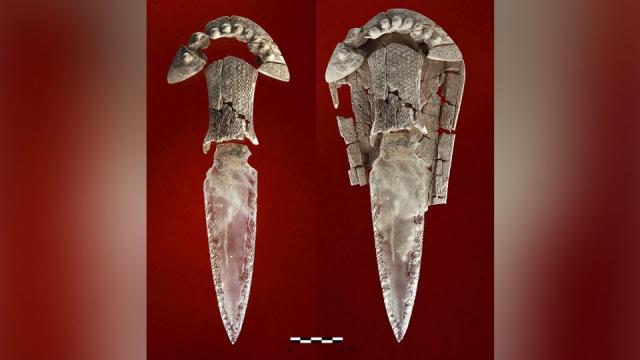
Piecing together the past can be an intricate puzzle.
Individual clues are assembled to capture a glimpse of someone’s life or paint a broader portrait of a distant civilization.
While analysis of DNA is one factor, archaeologists have relied on other clues to gain insight, such as grave goods. Whether or not the true meaning of these objects can ever be deciphered, they often symbolize an individual’s social standing, the role that person played or tools thought necessary for the afterlife.
European archaeologists made a “spectacular” find in 2008 of a tomb near Seville, Spain, that belonged to an ancient individual of great importance.
New research just revealed the discovery was even more unexpected than they realized.
A new method that involves analyzing tooth enamel was used to confirm that the skeleton belonged to a woman, and it has changed the way scientists interpret the entire site.
The Ivory Lady, who possibly held a leadership role, was likely revered by her society for generations after she died. Graves spanning 200 years after her death encircle the woman’s tomb.
“She must have been (a) highly charismatic person. She probably traveled or did have connections with people from faraway lands,” said archaeologist Leonardo García Sanjuán, a professor of prehistory at the University of Seville.
When SpaceX launched Starship in April, the most powerful rocket ever built left its mark on Boca Chica State Park in Texas.
As Starship’s engines roared to life for liftoff, they obliterated the launchpad and sent tangled rebar, chunks of concrete and other debris flying across the protected wilderness.
The park is home to birds such as snowy plovers, a species that experts believe has declined once SpaceX began testing and launching from the site five years ago.
The high-spirited squawks of yellow-crested cockatoos once carried across the rainforests of Indonesia until tens of thousands of the birds were poached from the wild in the 20th century to be kept as pets.
Only about 2,000 of the critically endangered birds remain — and 10% of them have taken up residence in an unlikely place: bustling Hong Kong.
At first glance, one of the largest marine animals that prowled the seas 508 million years ago looks like a fearsome predator. But the shrimplike creature, called Anomalocaris canadensis, may just be misunderstood.
Scientists created a 3D reconstruction of the animal, which had an armored mouth, to see how it hunted.
When the Ingenuity helicopter took off for its 52nd flight on Mars in April, the little chopper didn’t phone home to let NASA know it landed safely. The silence stretched on for 63 days.
As Ingenuity and the Perseverance rover begin to explore more challenging terrain, obstacles can block communications between the two — and Perseverance is the only one that can “call” Earth.
Don’t miss out on these stories:
Catastrophic climate 'doom loops' could start in just 15 years, new study warns
Climate "tipping points," such as the loss of the Amazon rainforest or the collapse of the Greenland ice sheet, could come within a human lifetime, scientists have said.
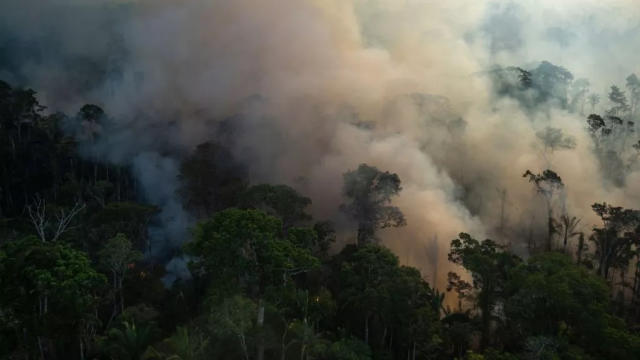
Earth's ecosystems may be careering toward collapse much sooner than scientists thought, a new study of our planet's warming climate has warned.
To understand how rising temperatures and other environmental stressors could cause complex ecosystems to break down, scientists use computer models to simplify ecosystems' dynamics, enabling them to predict the fate of those ecosystems — and when their tipping points could be reached.
The researchers behind the new study say this prediction is too optimistic.
According to the researchers, most tipping-point studies build the math in their models to focus on one predominant driver of collapse, for example deforestation in the Amazon rainforest. However, ecosystems aren't contending with just one problem but rather a swarm of destabilizing factors that compound one another. For example, the Amazon also faces rising temperatures, soil degradation, water pollution and water stress.
To investigate how these elements interact and whether these interactions can, in fact, hasten a system's demise, the scientists behind the new study built computer models of two lake and two forest ecosystems (including one which modeled the collapse of civilization on Easter Island) and ran them more than 70,000 times while adjusting the variables throughout.
After testing their systems across multiple modes — with just one cause of collapse acting, with multiple causes acting and with all of the causes plus the introduction of random noise to mimic fluctuations in climate variables — the scientists made some troubling findings: multiple causes of collapse acting together brought the abrupt transformation of some systems up to 80% closer to the present day.
Related Stories:
And even when the main cause of collapse was not allowed to increase with time, 15% of the collapses occurred purely because of the new elements.
This means that significant social and economic costs from climate change might come much sooner than expected, leaving governments with even less time to react than first thought.
Life on Venus? Intriguing molecule phosphine spotted in planet's clouds again
More evidence of the potentially life-indicating molecule phosphine has been discovered in Venus' atmosphere, opening the next chapter in a heated debate.
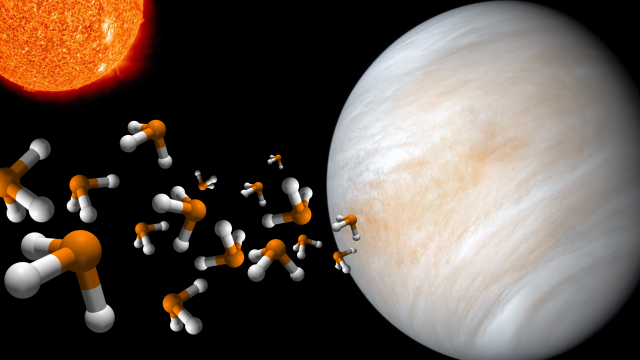
The Venus phosphine saga continues.
However, even if there is phosphine in the Venusian atmosphere, it doesn't necessarily mean the planet hosts life. Abiotic processes, some of which we don't fully understand, could also be generating the stuff on Venus.
"There’s a big school of thought that you can make phosphine by lobbing phosphorus-bearing rocks up into the high atmosphere and kind of eroding them with water and acid and stuff and getting phosphine gas," Greaves said during her talk.
"I vaguely remembered Venus is supposed to have this potential habitat in the high clouds, which is anaerobic, and we eventually got telescope time, so I thought, 'Why don’t we have a very quick look and see if there’s some phosphates in Venus clouds, an analog to things living on the surface of the Earth?'" Greeaves said. "Astonishingly, we found it, and all hell broke loose!"
The potential detection sparked a flurry of follow-up research, some of which was conducted by teams consisting of scientists involved in the initial phosphine detection, that failed to turn up the molecule. And these new findings from Greaves and her team are likely to prompt even more follow-up investigations.
Manchester clean air zone delayed again over bus technology
Greater Manchester's plan will be delayed as some retrofitted buses did not cut emissions as expected.

Plans for a clean air zone in Greater Manchester will be delayed again after it emerged claims about reduced bus emissions may not be accurate.
About 1,150 of the region's 2,063 buses were modified at a cost of £15m to cut levels of nitrogen dioxide.
However the government has paused the rollout after some retrofitted buses were not cutting emissions as expected.
Local officials said they still hoped to comply with legal limits on nitrogen dioxide by 2026.
The proposal for the Greater Manchester CAZ has been on hold since February 2022 after a backlash to potential charges for users of certain vehicles.
Local officials had been due to provide the government with updated data about expected reductions in air pollution this month but that will now be delayed due to the paused rollout.
A spokeswoman for Clean Air Greater Manchester said the buses' introduction would still contribute to "a significant improvement in air quality, tackling not just nitrogen dioxide but other pollutants too".
She said local leaders "remain committed to an investment-led, non-charging GM Clean Air Plan" and that "work is continuing to ensure that we deliver compliance with legal limits for nitrogen dioxide as soon as possible and by 2026 at the latest".
The government has launched a review of the retrofit technology, which is set to conclude this autumn.
A government spokeswoman said they would "work closely with local councils to help them improve air quality, including with using technology to help improve bus emissions".
"We have paused the rollout of bus retrofit technology and are conducting further research to understand the technology and to work out how best it could be improved."
0 Likes
